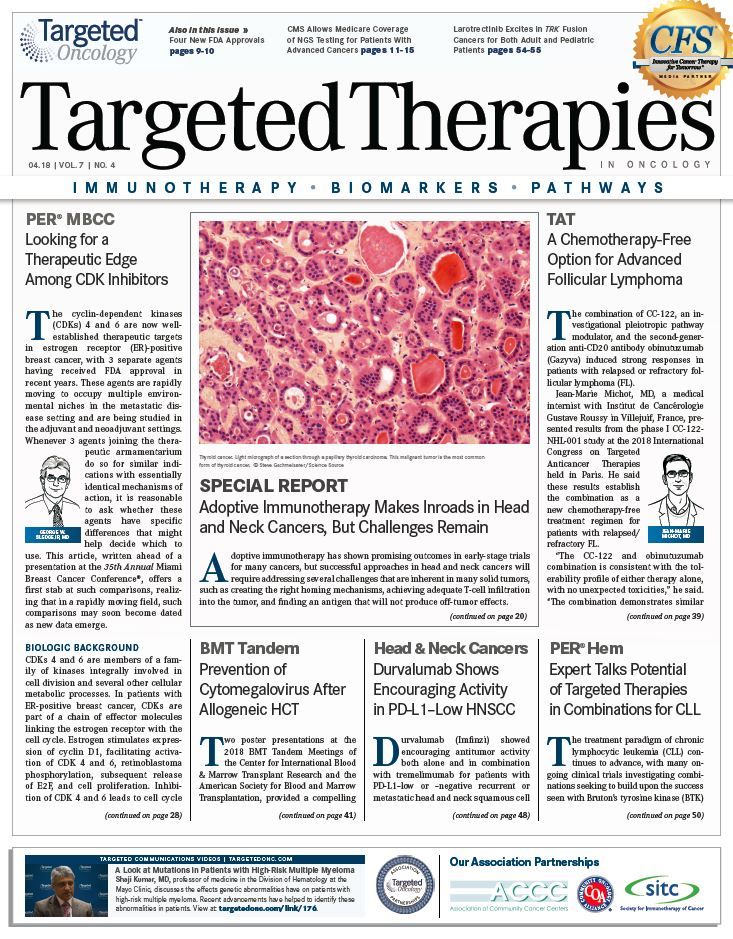Durvalumab Shows Encouraging Activity in PD-L1-Low HNSCC
Durvalumab showed encouraging antitumor activity both alone and in combination with tremelimumab for patients with PD-L1–low or –negative recurrent or metastatic head and neck squamous cell carcinoma, according to results of the CONDOR trial presented at the 2018 Multidisciplinary Head and Neck Cancer Symposium in Scottsdale, Arizona.

Durvalumab (Imfinzi) showed encouraging antitumor activity both alone and in combination with tremelimumab for patients with PD-L1low or –negative recurrent or metastatic head and neck squamous cell carcinoma (HNSCC), according to results of the CONDOR trial presented at the 2018 Multidisciplinary Head and Neck Cancer Symposium in Scottsdale, Arizona.
Of the 17 patients who achieved a partial response, the primary endpoint of overall response rate (ORR) was 7.8% for those (n = 10) treated with durvalumab in combination with tremelimumab, a CTLA-4 inhibitor, compared with 9.2% of the group (n = 6) receiving durvalumab alone and 1.6% of patients (n = 1) treated with tremelimumab alone, at 12 months. The ORR for durvalumab monotherapy was consistent with other single-agent PD-1/PD-L1 inhibitors in this setting.
“Immunotherapy, especially immune checkpoint inhibitors, has already demonstrated promising activity in squamous cell cancer of the head and neck. In the CONDOR study, we are focusing on 2 agents,” noted first author Lilian L. Siu, MD, during her presentation. “The 2 drugs in combination have preclinical synergy as well as clinical demonstration of enhanced activity. Therefore, it makes sense that these 2 pathways that are not redundant be combined together in this setting of the CONDOR study, where there is clearly a clinical unmet need.”
The randomized, open-label, multicenter phase II trial included 267 patients with recurrent or metastatic HNSCC of the oral cavity, oropharynx, hypopharynx, and larynx who had not responded to prior platinum-based chemotherapy in the recurrent or metastatic setting. Patients were stratified by human papillomavirus and smoking status, then were randomized in a 1:1:2 ratio to receive durvalumab alone at 10 mg/kg IV every 2 weeks (n = 67), tremelimumab alone at 10 mg/kg IV every 4 weeks for 7 doses followed by 2 additional doses every 12 weeks (n = 67), or 20 mg/kg of durvalumab in combination with 1 mg/kg of tremelimumab every 4 weeks for 4 cycles and then durvalumab at 10 mg/kg every 2 weeks for up to 12 months (n = 133). PD-L1low or –negative status was defined as less than 25% expression on the tumor cells.
Safety and toxicity profiles across all arms were consistent with similar immunotherapeutic agents. Treatment-related adverse events (TRAEs) of any grade were highest for durvalumab alone (any grade, 63%), followed by durvalumab plus tremelimumab (58%) and tremelimumab alone (55%). The most common TRAEs were diarrhea, asthenia, fatigue, and hypothyroidism.
Grade 3 or higher TRAEs were experienced by 15% of patients across the study, including 12% in the durvalumab monotherapy arm, 17% taking tremelimumab alone, and 16% in the combination arm. The most common grade 3 or higher TRAEs were diarrhea, anemia, asthenia, and fatigue; however, all incidences were less than 5% across all arms and were consistent with what is currently known from these agents.
Twelve of the 267 enrolled patients discontinued therapy due to TRAEs, including 7 patients in the combination arm and 5 in the tremelimumab arm. No patients in the durvalumab-alone group discontinued treatment. The combination arm had 1 death after the patient experienced treatment-related grade 3 acute respiratory failure.
Secondary endpoints for all arms included duration of response (DOR), disease control rate, best response, progression-free survival (PFS), and overall survival (OS). PFS and OS between the combination arm and the monotherapy arms were also compared. Other secondary endpoints for all arms included safety, tolerability, and quality of life, which will be presented at a later date, noted Siu, director of the Phase I Program and co-director of the Robert and Maggie Bras and Family Drug Development Program at Princess Margaret Hospital in Toronto, Canada.
Median OS was 7.6 months for durvalumab plus tremelimumab, 6.0 months for durvalumab, and 5.5 months for tremelimumab. Median PFS was approximately 2.0 months across all arms, with no observed difference in clinical activity. The DOR was 9.4 months in the combination arm and has not been reached in either of the monotherapy arms. “At the time of the data cutoff, we still have ongoing responses in many of these patients,” Siu said.
“Two immunotherapies have already been approved for use in platinum-refractory recurrent or metastatic head and neck cancer, but not all patients respond to these therapies,” Siu said in a statement. “For immunotherapy to increase its clinical utility, it’s important that we can better identify the patients who will most likely respond to treatment.”
Previously, the phase II HAWK study demonstrated similar safety and efficacy of durvalumab monotherapy for patients with PD-L1high recurrent or metastatic HNSCC.2 The CONDOR trial is the first to show these findings in patients with recurrent or metastatic HNSCC and low or negative PD-L1 expression. Both populations are included in the ongoing phase III EAGLE trial, which is assessing the combination of durvalumab plus tremelimumab and durvalumab monotherapy compared with standard of care as second-line treatment in patients with recurrent or metastatic HNSCC (NCT02369874).
References:
- Siu LL, Even C, Mesía R, et al. A randomized, open-label, multicenter, global phase II study of durvalumab, tremelimumab, or durvalumab plus tremelimumab in patients with PD-L1 low/negative recurrent or metastatic head and neck squamous cell carcinoma: CONDOR. Presented at: the 2018 Multidisciplinary Head and Neck Cancer Symposium; February 13-17, 2018; Scottsdale, AZ. Abstract 1. headandnecksymposium.org/uploadedFiles/Head_and_Neck_Symposium/2018_ Head_and_Neck_Symposium/Abstracts/CompleteHeadNeckPapers.pdf.
- Zandberg D, Algazi A, Good JS, et al. Durvalumab for recurrent/metastatic (R/M) head and neck squamous cell carcinoma (HNSCC): preliminary results from a single-arm, phase 2 study. Presented at: the 2017 ESMO Congress; September 8-12, 2017; Madrid, Spain. Abstract 1042O. esmo.org/ content/download/117241/2057634/file/ESMO-2017-Abstract-Book.pdf.

Powell Reviews Updated IO/TKI Data and AE Management in Endometrial Cancer
April 18th 2024During a Case-Based Roundtable® event, Matthew A. Powell, MD, discussed the case of a patient with advanced endometrial cancer treated with lenvatinib plus pembrolizumab who experienced grade 2 treatment-related hypertension.
Read More
Savona Discusses First-Line JAK Inhibition for Patients With Myelofibrosis at Risk of Anemia
April 17th 2024During a Case-Based Roundtable® event, Michael Savona, MD, and participants discussed the case of a patient with myelofibrosis and moderate anemia receiving JAK inhibitor therapy.
Read More
Biomarker Testing Paves the Way for Better Targeted Therapies in NSCLC
April 16th 2024At a live virtual event, Edward S. Kim, MD, MBA, discussed the evolving landscape of biomarker testing before making treatment decisions for patients with early-stage non–small cell lung cancer (NSCLC).
Read More
Creating Solutions for a 'Continual State of Transition' in Cancer Care
April 15th 2024In a Peers & Perspectives in Oncology feature article, we focus on the importance of the transition-of-care process for patients with cancer as they move from the inpatient to outpatient setting, as well as between lines of therapy with comments from Marc J. Braunstein, MD, PhD, and Michael Shusterman, MD.
Read More